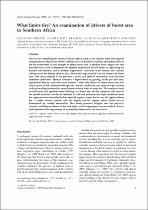JavaScript is disabled for your browser. Some features of this site may not work without it.
- ResearchSpace
- →
- Research Publications/Outputs
- →
- Journal Articles
- →
- View Item
| dc.contributor.author |
Archibald, SA

|
|
| dc.contributor.author |
Roy, DP

|
|
| dc.contributor.author |
Van Wilgen, BW

|
|
| dc.contributor.author |
Scholes, RJ

|
|
| dc.date.accessioned | 2009-06-04T12:50:58Z | |
| dc.date.available | 2009-06-04T12:50:58Z | |
| dc.date.issued | 2009-03 | |
| dc.identifier.citation | Archibald, SA, Roy, DP, Van Wilgen, BW and Scholes, RJ. 2009. What limits fire? an examination of drivers of burnt area in Southern Africa. Global Change Biology (Blackwell), Vol. (2008), pp 1-18 | en |
| dc.identifier.issn | 1354-1013 | |
| dc.identifier.uri | http://hdl.handle.net/10204/3415 | |
| dc.description | Author Posting. Copyright Blackwell Publishing, 2009. This is the author's version of the work. It is posted here by permission of Blackwell Publishing for personal use, not for redistribution | en |
| dc.description.abstract | The factors controlling the extent of fire in Africa south of the equator were investigated using moderate resolution (500 m) satellite-derived burned area maps and spatial data on the environmental factors thought to affect burnt area. A random forest regression tree procedure was used to determine the relative importance of each factor in explaining the burned area fraction and to address hypotheses concerned with human and climatic influences on the drivers of burnt area. The model explained 68% of the variance in burnt area. Tree cover, rainfall in the previous 2 years, and rainfall seasonality were the most important predictors. Human activities – represented by grazing, roads per unit area, population density, and cultivation fraction – were also shown to affect burnt area, but only in parts of the continent with specific climatic conditions, and often in ways counter to the prevailing wisdom that more human activity leads to more fire. The analysis found no indication that ignitions were limiting total burnt area on the continent, and most of the spatial variation was due to variation in fuel load and moisture. Split conditions from the regression tree identified (i) low rainfall regions, where fire is rare; (ii) regions where fire is under human control; and (iii) higher rainfall regions where burnt area is determined by rainfall seasonality. This study provides insights into the physical, climatic, and human drivers of fire and their relative importance across southern Africa, and represents the beginnings of a predictive framework for burnt area | en |
| dc.language.iso | en | en |
| dc.publisher | Blackwell Publishing | en |
| dc.subject | Climatic control | en |
| dc.subject | Dry season | en |
| dc.subject | Veld fires analysis | en |
| dc.subject | Ignitions | en |
| dc.subject | Weather | en |
| dc.subject | Fire regimes | en |
| dc.subject | Fuel | en |
| dc.subject | Predictive model | en |
| dc.subject | Regression tree model | en |
| dc.subject | Fire drivers | en |
| dc.title | What limits fire? an examination of drivers of burnt area in Southern Africa | en |
| dc.type | Article | en |
| dc.identifier.apacitation | Archibald, S., Roy, D., Van Wilgen, B., & Scholes, R. (2009). What limits fire? an examination of drivers of burnt area in Southern Africa. http://hdl.handle.net/10204/3415 | en_ZA |
| dc.identifier.chicagocitation | Archibald, SA, DP Roy, BW Van Wilgen, and RJ Scholes "What limits fire? an examination of drivers of burnt area in Southern Africa." (2009) http://hdl.handle.net/10204/3415 | en_ZA |
| dc.identifier.vancouvercitation | Archibald S, Roy D, Van Wilgen B, Scholes R. What limits fire? an examination of drivers of burnt area in Southern Africa. 2009; http://hdl.handle.net/10204/3415. | en_ZA |
| dc.identifier.ris | TY - Article AU - Archibald, SA AU - Roy, DP AU - Van Wilgen, BW AU - Scholes, RJ AB - The factors controlling the extent of fire in Africa south of the equator were investigated using moderate resolution (500 m) satellite-derived burned area maps and spatial data on the environmental factors thought to affect burnt area. A random forest regression tree procedure was used to determine the relative importance of each factor in explaining the burned area fraction and to address hypotheses concerned with human and climatic influences on the drivers of burnt area. The model explained 68% of the variance in burnt area. Tree cover, rainfall in the previous 2 years, and rainfall seasonality were the most important predictors. Human activities – represented by grazing, roads per unit area, population density, and cultivation fraction – were also shown to affect burnt area, but only in parts of the continent with specific climatic conditions, and often in ways counter to the prevailing wisdom that more human activity leads to more fire. The analysis found no indication that ignitions were limiting total burnt area on the continent, and most of the spatial variation was due to variation in fuel load and moisture. Split conditions from the regression tree identified (i) low rainfall regions, where fire is rare; (ii) regions where fire is under human control; and (iii) higher rainfall regions where burnt area is determined by rainfall seasonality. This study provides insights into the physical, climatic, and human drivers of fire and their relative importance across southern Africa, and represents the beginnings of a predictive framework for burnt area DA - 2009-03 DB - ResearchSpace DP - CSIR KW - Climatic control KW - Dry season KW - Veld fires analysis KW - Ignitions KW - Weather KW - Fire regimes KW - Fuel KW - Predictive model KW - Regression tree model KW - Fire drivers LK - https://researchspace.csir.co.za PY - 2009 SM - 1354-1013 T1 - What limits fire? an examination of drivers of burnt area in Southern Africa TI - What limits fire? an examination of drivers of burnt area in Southern Africa UR - http://hdl.handle.net/10204/3415 ER - | en_ZA |






